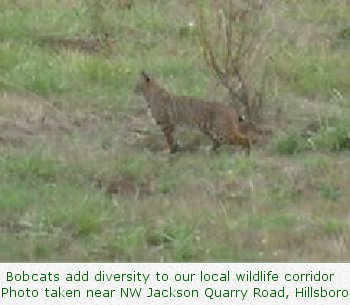Wildlife Habitat
Candidate Reserve Study Area
North of Highway 26
August 14, 2009
Written by.............................. Cherry Amabisca, M.B.A.
Field Survey ........................... Mary Pruitt, A.A.
Reviewed by............................ Catherine Keith, B.A. Biology, M.B.A. B.H.S.A.I.
Submitted by . . . . . . . . . . . . . . . . . . . SaveHelvetia.org
A local citizens' group whose goal is to preserve
all land north of Highway 26 as Rural Reserves
Justification for designation as RURAL RESERVES under RR (3) (c)
Are important fish, plant or wildlife habitat per OAR 660-027-0060(3)(c)
|
RR (3) (c) This area is an important fish, plant or wildlife habitat
Scope and Intent
At the request of the Steering Committee for SaveHelvetia.org, a citizens' group dedicated to preserving all land in the reserve study area north of Highway 26 as RURAL RESERVES, we undertook an assessment of the Roosevelt elk herds that utilize lands north of Highway 26. Our intent was to determine the number of elk which use this area as their habitat, how long they have used the study area and the areas used. While it is recognized by ODFW personnel that the elk roam as far as the Coast Range, we limited our survey to an area north of Highway 26 with the following approximate boundaries:
South: Highway 26
East: Eastern edge of Washington County line
North: Skyline Boulevard
West: Mountaindale Road, east of North Plains
Survey
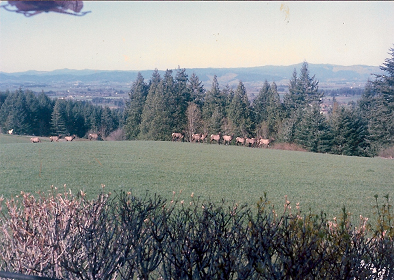
|
Elk herd heading north near NW Logie Trail, Hillsboro
View west to the Coast Range |
The community survey was conducted during the period July 16, 2009 to August 13, 2009. We went out to the community in the area north of Highway 26 and asked the following questions:
Had they seen elk on their property?
If so, when? Which years?
How many did they see? What did the elk do on their property?
We contacted residents by e-mail, phone and in person. Mary Pruitt contacted many homeowners of properties and collected photos. She utilized her personal knowledge of the locations of the herds over the past several months. Because of time constraints, we were unable to survey some areas; this lack of data does not indicate that the elk are not using those areas.
Results
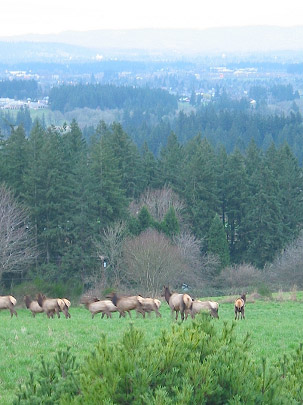
|
Elk herd in forested area
overlooking Tualatin Valley
Photo taken near NW Brooks Road, Portland |
Elk herd sightings were reported on more than 80 properties. Many residents responded with photos and comments.
Sightings were from as far east as Brooks Road and Kaiser Road, south to within one-quarter mile of Highway 26, as far north as Solberger Road and as far west as Mountaindale Road.
The number of elk seen at any one time ranged from a group of 20 to a group of 82, with the majority of sightings in the 35 to 40 range.
The earliest sightings were reported as far back as 1965. One homeowner reported they came every fall for the past 40 years. One homeowner reported they came every six weeks since 1980. Another reported that they came three to four times a year since 1977. Many homeowners reported that they came every fall or winter. One homeowner reported that they came whenever there were heavy snows in the Coast Range.
Homeowners reported that the elk fed on pumpkins, fallen apples, red clover, wine grapes, peas and mown grass in addition to grasses and forbs.
Locations of elk sightings were posted on topographical maps of the candidate areas with codes that corresponded with the data base of sightings.
In addition to elk, homeowners reported sightings of bobcats and cougars, six sightings each. These sightings were also posted on the topographical maps, but in different colors.
What we learned
- Forest Park is considered an important anchor to our region's open spaces network. The Forest Park Connections area (on the Natural Landscape Features Inventory) secures the integrity of the "big game" corridor that links the park with habitat in the northern Coast Range. Rock Creek headwaters also provide wildlife habitat and trail connectivity from the Tualatin Valley to the Tualatin Mountains that includes Forest Park. (1)
- Based on the sightings, Roosevelt elk not only range throughout the candidate rural reserve study area north of Highway 26, but they also range throughout the overlapping candidate urban reserve study area as well, south to within one-quarter mile of Highway 26. The sightings demonstrate that the elk use the wildlife corridor from Forest Park to
the area west of North Plains.
- According to the ODFW Elk Management Plan, their standard diet is grasses and forbs and shrubs; forage which is high in nutrients and easily digestible. (2) They supplement their diet with a variety of seasonal fruits and vegetables: peas, pumpkins, apples, wine grapes, mown grass.
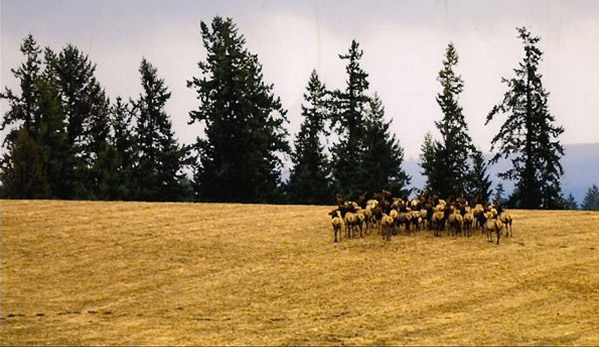
|
Elk herd in open field - Coast Range in the distance
Photo taken near NW Helvetia Road, Hillsboro
|
- Elk need habitat with a mix of open fields with grasses and shrub/forest to obtain the necessary nutritious forage.
- This summer (2009) we have had multiple herds sighted in different parts of the area at the same time.
- There are two known calving sites located in forest areas close to the proposed urban reserve area. These sites will remain undisclosed in order not to compromise the herds.
- Based on reports from residents, these herds are "historical" herds; they have been consistently sighted throughout the area on a regular basis for over 45 years.
|
Conclusion
We conclude that there are multiple herds of Roosevelt elk that use the area north of Highway 26, both in the urban reserve study area and the rural reserve study area.
We conclude that this area is crucial habitat and a wildlife corridor.
The area north of Highway 26 should be preserved as Rural Reserves under OAR 660-027-0060(3)(c) in order to maintain this crucial habitat and wildlife corridor needed for survival and species diversity by the herds of Roosevelt elk that inhabit this area.
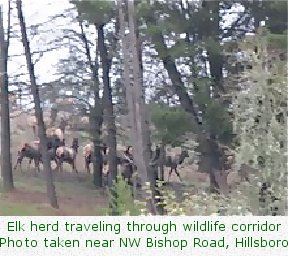
|
How does the area north of Highway 26 provide crucial habitat for elk?
The land north of Highway 26 provides ALL the elements of crucial habitat for the elk.
The land north of Highway 26 provides space. In spite of fencing on many of the properties, they are able to roam great distances, from Germantown Road on the east to Mountaindale Road in the west. Elk need to roam. They have been documented trekking more than 50 miles in a single day. (8) Bulls travel many miles in order to breed with other females from other herds. This is essential for genetic diversity and survival of the species.
The land north of Highway 26 provides food. Elk need to eat 10 to 15 pounds of vegetation per day. During the summers and fall, they range south of the Tualatin 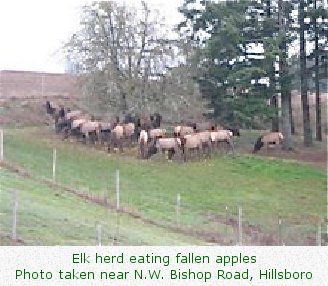 Mountains to within 1/4 mile of Highway 26 to feed. Open fields with grasses and forbs are supplemented by pumpkins, fallen apples, winegrapes,and mown grass as the elk build up fat reserves to carry them through the mating season (the rut) and the winter. Mountains to within 1/4 mile of Highway 26 to feed. Open fields with grasses and forbs are supplemented by pumpkins, fallen apples, winegrapes,and mown grass as the elk build up fat reserves to carry them through the mating season (the rut) and the winter.
The land north of Highway 26 provides water. Water is available from local creeks north of Highway 26, such as Jackson Creek, Holcolmb Creek, Rock Creek, Waible Gulch and McKay Creek.
The elk herds find shelter in the shrubs and trees intermixed with the open fields in the area north of Highway 26. In fact, at least one forested property offers so much seclusion that the pregnant cows return to it every year for calving. Shelter for elk serves two purposes: It protects them from cold, rain and snow and it gives them a place to hide from predators. The area north of Highway 26 contains many large parcels of forested land.
|
How does the area north of Highway 26 serve as an important wildlife corridor?
Our local wildlife corridor, the Forest Park Connection, extends from Forest Park in Portland to the Coast Range. It remains a largely intact connected habitat.
The area north of Highway 26 offers a rich habitat of food, water, shelter and space for a diverse variety of animals: deer, elk, black bear, bobcat and cougar.
|
Why designate the area north of Highway 26 RURAL RESERVES under RR(3)(c) Wildlife Habitat?
This area functions as a historical, diverse, wildlife habitat and wildlife corridor for big-game: elk, deer, as well as bobcats and cougars. Replacing rural properties with urban homes and industrial use factories will eliminate portions of this wildlife corridor. Urbanizing any part of it will negatively affect the species in the entire corridor. It will alter the patterns of wildlife movement in ways that may not be desirable.
Homes and industrial development in this area would eliminate important elk habitat. When land is converted to human land uses, habitat is lost and the remaining habitat is altered due to fragmentation and degradation.
Increased traffic and human activity will be deadly - to the elk and to residents. The elk cross many roads in their roaming and collisions with vehicles will increase as traffic increases and roads to accommodate the proposed housing densities. Additional traffic on Cornelius Pass Road could effectively block the critical wildlife corridor between Forest Park and the Coast Range, and would put more drivers at risk.
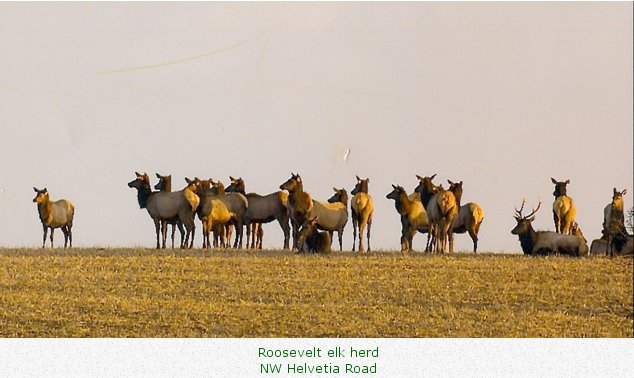
|
Background
What are crucial habitats and important wildlife corridors?
According to the Western Wildlife Habitat Council, Crucial Habitats are places containing the resources, including food, water, shelter and space, that contribute to survival and reproduction of wildlife. Crucial habitats also provide important wildlife corridors that contribute to biodiversity of species. Unlike "critical habitat" (areas need to recover endangered species), crucial habitats are those lands and waters needed to conserve a broad array of wildlife that make Oregon unique. (9)
Why are crucial habitats important?
Many crucial habitats support a high diversity of fish, wildlife and plants. Areas of high diversity are more resilient to stresses such as drought, floods, pest infestations, disease outbreaks or changes in climatic conditions. (9) Crucial habitats are necessary to prevent unacceptable declines of wildlife populations.
What are wildlife corridors?
Important Wildlife Corridors are crucial habitats that provide connectivity over different time scales (including seasonal or longer), among areas used by animal and plant species." (3)
Why is habitat connectivity important?
Conservation biologists recommend maintaining landscape "connectivity" to ensure biodiversity within species. (4) Elk herd bulls travel with their harem to mate with female cows in other territories. Mating outside of his harem ensures genetic diversity and reduces the negative effects of inbreeding. Elk need expansive intact corridors in order to travel the distances to find herds with acceptable females.
Habitat reduction is acknowledged as a primary cause of the decline of many species worldwide. (5) When habitats are fragmented, as happens with urbanization, it generally leads to smaller and more isolated animal populations. These populations are more susceptible to the negative effects of inbreeding. (6) Trying to connect multiple habitats after fragmentation is very difficult, expensive and disruptive. It is preferable to plan for landscape connectivity and preserve the natural corridors. Keeping habitats intact ensures diversity of fish, wildlife and plants; areas of high diversity are more resilient to stresses such as drought, floods, pest infestations, disease outbreaks or changes in climatic conditions.
|
Wildlife Movement Strategy - Who's Doing What?
At the regional level
Metro recognizes the significance of habitat links for wildlife and and asserts that Forest Park, which runs for eight miles along the northeast slope of the Tualatin Mountains, serves as a significant wildlife corridor. One of the Metro Council's goals and objectives for the Forest Park Connections target area is to acquire key properties in order to connect Forest Park to other public lands in order to keep important wildlife corridors intact. Both Metro's 1995 Natural Areas Program and Metro's 2006 Natural Areas Program contain goals to acquire land adjacent to the park to protect, maintain and expand habitats. (7)
At the state level
Oregon Department of Fish and Wildlife also recognizes the importance of wildlife corridors. ODFW staff and partners continue with plans for identifying wildlife corridors in Oregon with the goal of protecting wildlife as they move between habitats in search of food, mates and shelter. According to Audrey Hatch, the state biologist who wrote "The Oregon Conservation Strategy", research and work on wildlife corridors in Oregon is being collected through a number of agencies under the Oregon Wildlife Movement Strategy. She expects to include this new strategy in the next revision of The Oregon Conservation Strategy due to be released in 2011.
The goal of protecting the diversity of Oregon's wildlife is described in Oregon Administrative Rules, Oregon Department of Fish and Wildlife, Division 100, Wildlife Diversity Plan, OAR 635-100-0001 through 635-100-0194. As stated in OAR 635-100-0010, it is the goal of the Wildlife Diversity Program to maintain Oregon's wildlife diversity by protecting and enhancing populations and habitats of native wildlife at self-sustaining levels throughout natural geographic ranges by assessing, conserving and enhancing wildlife habitats. (10)
Additionally, one of the objectives stated in ODFW's Elk Management Plan is to maintain, enhance and restore elk habitat so that herd populations can be maintained at or near their established Management Objectives. (2)
In the West
According to the Western Governors' Association, there are several reasons why wildlife corridors are important for western states. The natural beauty and landscapes create a quality of life in the the West that attracts new residents who contribute additional talent, economic activity and jobs to the region. Large, intact and functioning ecosystems, healthy fish and wildlife populations and public access to natural landscapes contribute to the West's quality of life and economic well-being. Important wildlife movement corridors and crucial wildlife habitats within these landscapes are critical to maintaining these Western qualities. (9)
In 2007, Western Governors, including Governor Kulongoski of Oregon, unanimously approved resolution (07-01) Protecting Wildlife Migration Corridors and Crucial Wildlife Habitat in the West. In 2008, the Western Governors adopted the "Wildlife Corridors Initiative Report." At the same time, the Governors established the Western Governors Wildlife Council (WGWC). The mission of the WGWC is to "identify key wildlife corridors and crucial wildlife habitats in the West and to develop and coordinate implementation of needed policy options and tools for preserving those landscapes." (3)
|
Appendices
| RR3c - 3.1.1 |
Elk Survey Data Log, Area North of Highway 26
Survey Log also includes separate sightings for bobcats and cougars |
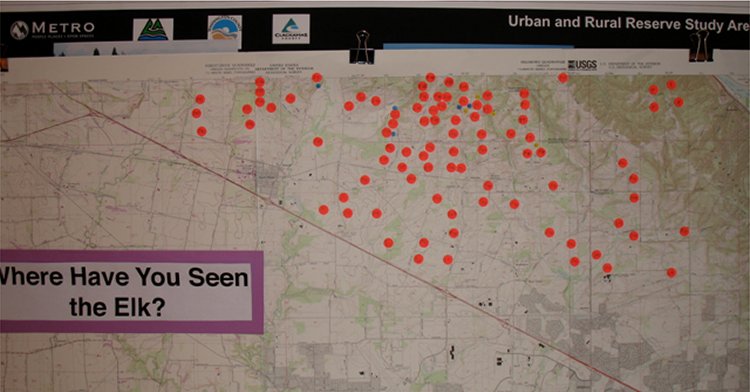
Each orange dot represents a homeowner sighting of one of the Roosevelt elk herds that live in the wildlife habitat north of Highway 26. Tualatin Mountains are at the top of the map. Highway 26 is the diagonal line. The wildlife corridor used by these herds runs from Forest Park on the top right towards the Coast Range (off the map on the left). The code on each orange dot corresponds to an entry in the attached Wildlife Survey Data Log. Blue dots correspond to bobcat sightings; yellow dots correspond to cougar sightings.
|
Works Cited
- "Natural Landscape Features Inventory". Portland, Oregon. Metro Regional Government, February 2007. p. 11
- "Oregon's Elk Management Plan". February 2003. Oregon Department of Fish and Wildlife.
- Western Governors' Association. "Western Governors' Wildlife Council (WGWC), July 19, 2009.
On-line:
http://www.westgov.org.wga/initiatives/corridors/index.htm
- Noss, R.F. 1983. "A regional landscape approach to maintain diversity." BioScience 33:700-706.
- Harris, L. 1984. "The Fragmented Forest: Island Biogeography Theory and the Preservation of Biotic Diversity." The University of Chicago Press, Chicago.
- Gilpin, M.E. and M.E. Soule. 1986. "Minimum viable populations: Processes of species extinction." In: M.E. Soule (Ed.) Conservation Biology: the science of scarcity and diversity. p. 19-34.
- "Forest Park Connections". Portland, Oregon. Metro Regional Government, 2009.
- Rocky Mountain Elk Foundation. "Elk Habitat", July 30, 2009.
On-line: http://www.rmef.org/AllAboutElk/ElkHabitat/
- "Western Wildlife Habitat Council Established". June 29, 2008.
On-line: http://www.westgov.org/wga/puclicat/wildlife08.pdf
- "Wildlife Diversity Plan". Oregon Administrative Rules, Oregon Department of Fish and Wildlife, Division 100.
On-line: http://www.dfw.state.or.us/OARs/100.pdf
|
Acknowledgements
EditorCherry Amabisca
ContributorsCatherine Keith, B.A. Biology, M.B.A., B.H.S.A.I.
Mary Pruitt, Field Survey
Audrey Hatch, ODFW, Biologist
Metro Data Resource Center
PhotographsDavid Gardner
Leroy & Katy Goodwin
Elda Harris
Faun Hosey
Wendy Mortensen
Pieren Family
Charlie Young
Thanks to John Talbot for his assistance in preparing this document for web publication.
|
WILDLIFE Survey Data Log
Area north of Highway 26
July 16 - August 14, 2009
|
Elk
Bobcat
Cougar
|
Next: Oregon White Oak Survey (Quercus garryana)
Back to Making our case
|









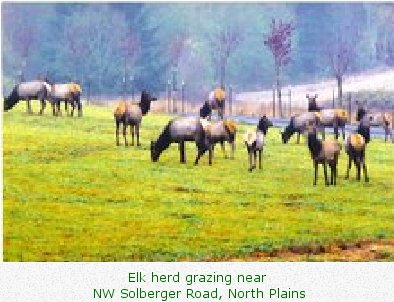




 Mountains to within 1/4 mile of Highway 26 to feed. Open fields with grasses and forbs are supplemented by pumpkins, fallen apples, winegrapes,and mown grass as the elk build up fat reserves to carry them through the mating season (the rut) and the winter.
Mountains to within 1/4 mile of Highway 26 to feed. Open fields with grasses and forbs are supplemented by pumpkins, fallen apples, winegrapes,and mown grass as the elk build up fat reserves to carry them through the mating season (the rut) and the winter.